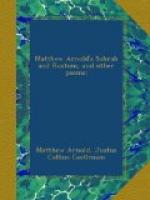Arnold, in a letter to his mother dated April, 1866, says of his poem: “Tell dear old Edward [Arnold] that the diction of the Thyrsis was modelled on that of Theocritus, whom I have been much reading during the two years this poem has been forming itself, and that I meant the diction to be so artless as to be almost heedless. However, there is a mean which must not be passed, and before I reprint this I will consider well all objections. The images are all from actual observation.... The cuckoo in the wet June morning, I heard in the garden at Woodford, and all those three stanzas, which you like, are reminiscences of Woodford. Edward has, I think, fixed on the two stanzas I myself like best: ‘O easy access,’ and ’And long the way appears.’ I also like ‘Where is the girl,’ and the stanza before it; but that is because they bring certain places and moments before me.... It is probably too quiet a poem for the general taste, but I think it will stand wear.” To his friend, John Campbell Shairp, Arnold wrote, a few days later: “Thyrsis is a very quiet poem, but, I think, solid and sincere. It will not be popular, however. It had long been in my head to connect Clough with that Cumner country, and, when I began, I was carried irresistibly into this form. You say, truly, that there was much in Clough (the whole prophetic side, in fact) which one cannot deal with in this way.... Still, Clough had the idyllic side, too; to deal with this suited my desire to deal again with that Cumner country. Anyway, only so could I treat the matter this time. Valeat quantum.” [204]
=1.= Note how the tone of the poem is struck in the first line.
=2. In the two Hinkseys.= That is, North and South Hinksey. See note, l. 125, The Scholar-Gipsy.
=4. Sibylla’s name.= In ancient mythology the Sibyls were certain women reputed to possess special powers of prophecy, or divination, and who claimed to make special intercession with the gods in behalf of those who resorted to them. Do you see why their “name” would be used on signs as here mentioned?
=6. ye hills.= See note, l. 30, The Scholar-Gipsy.
=14. Ilsley Downs.= The surface of East and West Ilsley parishes, in Berkshire, some twelve or fourteen miles south of Oxford, is broken by ranges of plateau-like hills, known in England as downs.
=15. The Vale.= White Horse Vale;
the upper valley of the River Ock, westward from Oxford.
=weirs=. See note, l. 95, The Scholar-Gipsy.
[205]
=19. And that sweet city with her dreaming spires.=
Arnold’s intense love for Oxford and the surrounding
country appears in many of his essays and poems.
In the introduction to his Essays on Criticism,
Vol. I, occurs the following tribute: “Beautiful
city! so venerable, so lovely, so unravaged by the
fierce intellectual life of our century, so serene!




